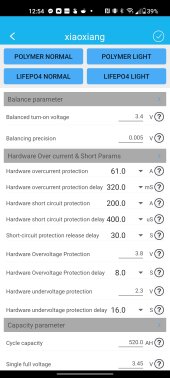Okay if that's actually a really easy solution... The JBD is highly programmable... I currently have it set to start balancing at 3.4 volts per cell...
OK, so with that BMS, you can only top balance - no way to bottom balance.
And the problem with that is that if you rarely charge above 3.4V / 13.6V, your balancer will never kick in and your balance will stray.
The other problem is that your balancer has a precision of 6mV.
So even if you program the balancer to start balancing at 3.375V and your battery regularly spends several hours charged above 13.5V, one cell can be at 3.381V while the others can be at 3.375V which is an 0.67% difference is SOC.
That’s about the best you can hope for. If you rarely charge above 13.6V and try to go lower, activating the balancer at 3.363V / 13.45V will only get you to a precision of 3% SOC (and it gets even worse at lower voltages).
I’ll say it one more time, trying to maintain a top-balanced battery in a system that rarely charges into the upper knee is a fool’s errand.
Leave your BMSs active balancer as is (where it will never get used), pick up a Heltec 4S Active BMS, and leave it running 24/7. Your battery will slowly become bottom-balanced and you’ll be much happier.
Top-balanced batteries are better for all those battery-based systems intended to provide backup power when the grid goes down. Those batteries rarely get discharged into the lower knee and are generally charged into the upper knee daily and held there as long as the sun is shining in CV mode.
But for systems like yours (and mine

) where the primary purpose of the battery is to capture excess solar energy generated during the day and to use that stored energy to offset loads overnight until the battery is depleted, a bottom-balanced battery makes much more sense…
[P.S. if the JBD BMS has an option you could check for ‘Bottom Balance’ which changed the meaning of ‘Balanced Turn-on Voltage’ from ‘Balance Turn-on Voltage Above’ to ‘Balance Turn On Voltage Below’ you wolf not need to purchase a stand-alone active balancer…]



